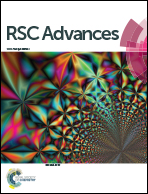Tailoring polyamide thin film composite nanofiltration membranes by polyethyleneimine and its conjugates for the enhancement of selectivity and antifouling property†
Abstract
Herein, we report a suitable surface modification process for a state-of-art poly(piperazineamide) thin film composite (TFC) nanofiltration (NF) membrane by polyethyleneimine (PEI) and its conjugates (PEI–polyethylene glycol and PEI–dextran) for the enhancement of monovalent ion to divalent ion selectivity and antifouling properties. The nascent TFC NF membrane was treated with PEI and its conjugates for the purpose of modification. The modified membranes exhibited high rejection of divalent cations (88–91%), high rejection of divalent anions (85–92%) and low rejection of NaCl (30–50%). The membranes modified under optimized conditions exhibited considerably enhanced antifouling/anti-scaling properties, similar permeate flux, similar Na+ to SO42− selectivity and much better Na+ to Mg2+ selectivity compared to that of the pristine membrane during the desalination of water containing a mixture of salts and real seawater. The adjustment in permeation property and improvement in antifouling behaviour are attributed to the adjustment of surface charge and pore size by the incorporation of multi-amine containing antifouling polyethylene glycol or dextran on the membrane surface via the post modification process.


 Please wait while we load your content...
Please wait while we load your content...